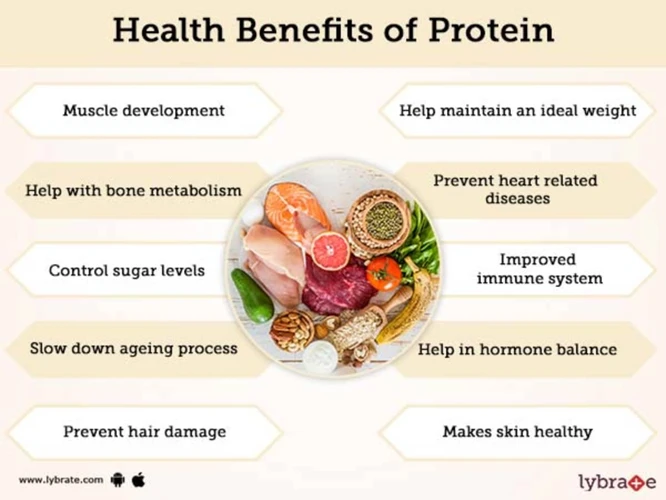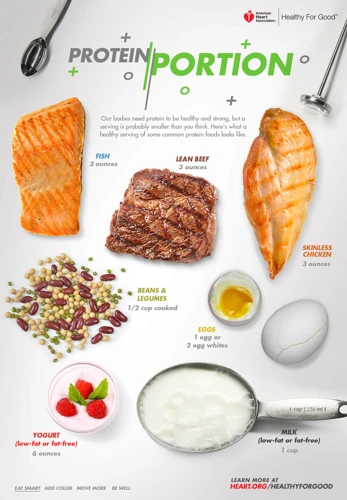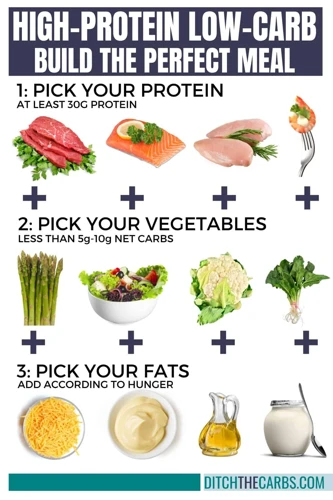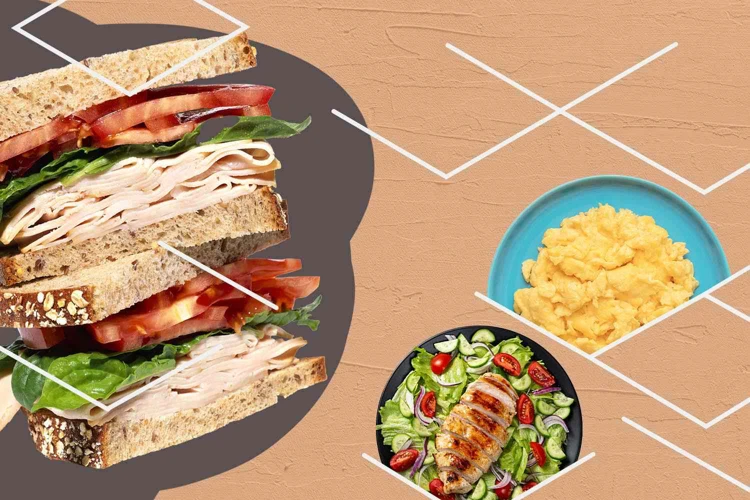Are you struggling to lose weight despite following a strict diet and exercise regimen? Incorporating protein in every meal could be the answer to your weight loss woes! Protein, known as the building blocks of the body, plays a key role in not only keeping you satiated but also in preserving your muscle mass. In this article, we will explore the importance of protein in weight loss, how much to incorporate in each meal, and easy ways to include protein in every meal. Additionally, we will also discuss healthy protein options to choose from, meal planning tips, and precautions you need to keep in mind. So, let’s dive in and discover how you can achieve your weight loss goals with the help of protein.
Why Protein is Important for Weight Loss

When it comes to effective weight loss, it’s not just about counting calories or cutting out certain food groups. Incorporating adequate amounts of protein into your diet can be a game-changer. Protein is an essential nutrient that helps to increase satiety, preserve muscle mass, and boost metabolism. In this section, we’ll explore the reasons why protein is so important for weight loss and discuss the benefits it offers.
Increase Satiety
Protein plays a crucial role in increasing satiety, which is the feeling of fullness after a meal. When you consume protein-rich foods, they take longer to digest, which means that you will feel fuller for longer periods of time. This is because protein activates the gut hormones that signal the brain to suppress appetite and reduce food intake.
In order to increase satiety through protein, consider incorporating the following high-protein foods into your meals:
- Lean meats: Opt for chicken, turkey, fish, or lean cuts of beef like sirloin.
- Eggs: Eggs are a great source of protein and can be enjoyed in many forms such as scrambled, hard-boiled, or omelets.
- Beans and legumes: Add beans like kidney beans or chickpeas to soups, salads or make it into a flavorful dip.
- Nuts and seeds: A handful of almonds, peanuts or a sprinkle of chia seeds can add crunch and protein to your meals.
- Dairy: Cheese, yogurt, and milk are high in protein and can be incorporated into meals, such as in smoothies, salads or as a snack.
Protein also helps to reduce snacking on high-carb, high-fat foods that are low in nutrients. By eating protein-rich foods, you are less likely to experience the crashes and sugar cravings that can occur with a high-carbohydrate meal.
Incorporating protein in every meal will help to increase satiety and reduce the likelihood of overeating or snacking on unhealthy foods.
Preserve Muscle Mass
Protein is not only crucial for satiety, but it also plays a crucial role in preserving muscle mass during weight loss. Preserving muscle mass is important because it keeps your metabolism high, which helps burn calories more efficiently. When you lose weight, you lose both fat and muscle mass, but a high protein diet can help minimize muscle loss.
Here is a comparison of the muscle mass preservation between a high protein diet and a low protein diet during weight loss:
| High Protein Diet | Low Protein Diet | |
|---|---|---|
| Muscle Mass Preservation | Preserves muscle mass effectively | May lead to muscle loss |
| Metabolic Rate | Keeps metabolic rate high due to preserved muscle mass | May slow down metabolic rate due to muscle loss |
As you can see, a high protein diet is much more effective in preserving muscle mass and keeping the metabolic rate high during weight loss. This is because protein is essential for building and repairing muscle tissue. If you are trying to lose weight, it is important to incorporate protein into your diet to minimize muscle loss and keep your metabolism running efficiently.
How Much Protein to Incorporate in Each Meal

To effectively lose weight with the help of protein, it is essential to consume the right amount of protein in every meal. As per dietary guidelines, the recommended daily protein intake is around 0.8 grams per kilogram of body weight. However, for people who are trying to lose weight, experts recommend increasing their protein intake to 1.2-1.6 grams per kilogram of body weight. This elevated protein consumption helps in increasing satiety, preserving muscle mass, and promoting fat loss.
To incorporate protein in every meal, it is recommended to consume around 20-30 grams of protein per meal. This quantity is enough to activate muscle protein synthesis and provide satiety throughout the day. If you are trying to figure out how to get this much protein at every meal, don’t worry, there are several options to choose from.
Starting the day with a protein-rich breakfast is a great way to get the required amount of protein at the beginning of the day. Adding eggs, dairy products like yogurt or cheese, nuts, or protein powder to your breakfast is an easy way to get a good start.
During lunch and dinner, people often turn towards meat as a primary source of protein. However, vegetarian protein sources like lentils, chickpeas, quinoa, tofu, tempeh, and nuts are equally great sources of protein. Including these plant-based sources in your meals can provide the necessary protein intake while helping to reduce the risk of heart disease and some cancers.
When it comes to snacks, people often choose high-carb or high-fat options that lead to overeating and weight gain. Instead, opt for a protein-rich snack like Greek yogurt, protein bars, edamame, or cheese. These snacks are not only filling and nutritious, but they also provide the necessary protein.
Incorporating protein in every meal is an effective way to lose weight while preserving muscle mass. Consuming 20-30 grams of protein per meal, through a combination of animal and plant-based sources, is recommended to meet the daily protein requirements.
Easy Ways to Include Protein in Every Meal

Incorporating protein in every meal may seem daunting at first, but it doesn’t have to be. There are plenty of simple ways to boost your protein intake without sacrificing taste or variety. By adding protein to every meal, you’ll not only be fueling your body for effective weight loss but also supporting overall health and wellness. Here are some suggestions for adding protein to breakfast, lunch, dinner, and snacks throughout your day.
Breakfast
Starting your day with a protein-packed breakfast can help you feel fuller for longer and prevent overeating throughout the day. Here are some easy yet tasty options to incorporate protein into your morning meal:
| Food | Protein Content (per serving) | Preparation Time |
|---|---|---|
| Eggs | 6g per large egg | 5-10 minutes |
| Greek Yogurt | 17g per 6oz serving | Instant |
| Protein Smoothie (made with protein powder, almond milk, fruit, and spinach) | 20-30g per serving (depending on protein powder used) | 5 minutes |
| Peanut Butter on Whole Grain Toast | 9g per 2 tbsp of peanut butter, 2g per slice of bread | 5 minutes |
| Cottage Cheese with Berries | 23g per 1 cup serving of cottage cheese | Instant |
Keep in mind that portion size and overall calorie intake are still important factors to consider when incorporating protein into your breakfast. Aim for a balanced meal with a variety of nutrients, including carbohydrates and healthy fats. By starting your morning with a protein boost, you’ll set yourself up for a successful day of healthy eating.
Lunch and Dinner
When it comes to incorporating protein into lunch and dinner, there are several options available.
One of the simplest ways to add protein to a meal is by including a source of meat, poultry, or fish. These options are not only high in protein but also provide essential nutrients such as iron, zinc, and omega-3 fatty acids. Some popular protein-rich options include:
| Protein Source | Protein Content (in grams) |
|---|---|
| Grilled chicken breast | 26g per 3 oz serving |
| Salmon | 22g per 4 oz serving |
| Lean ground beef | 18g per 3 oz serving |
| Turkey breast | 26g per 3 oz serving |
Vegans and vegetarians can opt for plant-based protein sources instead, such as tofu, tempeh, lentils, and beans. These options are also high in fiber, which promotes fullness and prevents overeating. Some protein-rich vegan and vegetarian options are:
| Protein Source | Protein Content (in grams) |
|---|---|
| Tempeh | 16g per 3 oz serving |
| Lentils | 9g per ½ cup serving |
| Black beans | 7g per ½ cup serving |
| Tofu | 10g per ½ cup serving |
In addition to these options, incorporating protein-rich veggies like spinach, broccoli, and Brussels sprouts can add additional protein to a meal.
It’s also important to note that portion size plays a role in maximizing the benefits of protein intake. Aim for a serving size of 3-4 ounces of animal-based protein or ½ to 1 cup of plant-based protein per meal.
Remember, a balanced diet includes more than just protein. It’s important to also incorporate a variety of fruits, vegetables, whole grains, and healthy fats into your meals for optimal health and weight loss.
Snacks
Snacking is an important part of keeping our bodies fueled throughout the day. When choosing snacks, it’s important to choose options that are high in protein to help keep us full and satisfied until our next meal. Here are some easy and healthy protein-rich snack options:
| Snack Option | Protein Content |
|---|---|
| Greek yogurt with berries | Approximately 18-20 grams per serving, depending on brand and type |
| Hard boiled eggs | Approximately 6 grams per egg |
| Edamame | Approximately 8 grams per 1/2 cup |
| Tuna on whole grain crackers | Approximately 12 grams per 3 oz of tuna |
| Protein smoothie with spinach and almond butter | Approximately 20 grams per serving |
When choosing snacks, it’s important to pay attention to portion sizes and to choose options that fit into your daily calorie and macronutrient goals. Incorporating protein in your snacks helps to promote weight loss by keeping you full, satisfied and less likely to overindulge in less healthy options.
Healthy Protein Options to Choose From

When it comes to incorporating protein into your meals, it’s important to choose the right sources of protein. Not all proteins are created equal, and some options are healthier than others. Here are some healthy protein options to choose from:
Poultry: Turkey and chicken are excellent sources of lean protein. They are low in fat and can be cooked in a variety of ways, making them a versatile option for any meal.
Seafood: Fish and shellfish are great sources of protein and omega-3 fatty acids. Salmon, tuna, and shrimp are especially good options.
Beans and Legumes: Lentils, black beans, kidney beans, and chickpeas are all high in protein and fiber. They can be used in a variety of dishes, such as soups, salads, and casseroles.
Nuts and Seeds: Almonds, walnuts, chia seeds, and hemp seeds are all good sources of protein. They are also high in healthy fats, which can help you feel full and satisfied.
Dairy: Greek yogurt, cottage cheese, and milk are all excellent sources of protein. They also contain calcium, which is important for bone health.
Eggs: Eggs are a great source of protein and can be cooked in a variety of ways. They are also a good source of healthy fats and vitamins.
When choosing your protein sources, it’s important to consider factors such as fat content, nutrient density, and whether the protein comes from an animal or plant-based source. By choosing a variety of healthy protein sources, you can ensure that you are getting all the nutrients your body needs.
Meal Planning Tips to Incorporate Protein

When meal planning, incorporating protein into every meal is essential for effective weight loss. Here are some tips to help you include protein in your meal planning:
1. Plan your protein sources
Incorporate a variety of protein sources into your meal planning, such as lean meats like chicken, turkey, and fish, as well as plant-based options like beans, lentils, quinoa, and nuts. Make sure to mix and match your protein sources to keep things interesting and flavorful.
2. Prep protein in bulk
Cooking large batches of proteins like chicken, beef, or tofu in advance can save you time and make meal planning easier. Portion them out and store them in the fridge or freezer for quick and easy meals later.
3. Use protein-rich ingredients in recipes
Incorporate protein-rich ingredients like quinoa, Greek yogurt, and lentils into your recipes. Quinoa can be used in salads, stir-fries, and as a grain substitute, while Greek yogurt can replace sour cream or be used in dips and dressings.
4. Add protein to snacks
Incorporate protein into your snacks by adding nut butter to fruit, adding hummus to veggies, or grabbing a hard-boiled egg on the go.
5. Be mindful of portion sizes
While protein is an important nutrient, it’s also important to be mindful of portion sizes. Aim for a minimum of 20-30 grams of protein per meal, but don’t go overboard – too much protein can strain your liver and kidneys.
Incorporating protein into every meal is a key strategy for effective weight loss. By planning your protein sources, prepping in bulk, using protein-rich ingredients, adding protein to snacks, and being mindful of portion sizes, you can make sure you’re getting the protein you need to fuel your weight loss journey.
Precautions
It is important to remember that incorporating protein in every meal does not mean going overboard with it. Too much of anything can be harmful to the body. Here are some precautions to keep in mind when incorporating protein in your meals for effective weight loss:
Avoid processed meats: Processed meats such as sausages, bacon, and deli meats are high in sodium, unhealthy fats, and preservatives. These meats should be avoided or consumed in moderation.
Diversify protein sources: While it is important to incorporate protein in every meal, it is equally important to diversify protein sources. Eating the same protein source every day can lead to an imbalance of nutrients in the body. Try incorporating different protein sources such as eggs, chicken, turkey, seafood, beans, lentils, and tofu.
Watch portion sizes: Remember that portion sizes matter. Consuming too much protein can lead to weight gain, just like consuming too little can lead to muscle loss. A palm-sized portion of protein is generally recommended for each meal.
Consult a healthcare professional: If you have any health conditions or concerns, it is always best to consult a healthcare professional before making any significant changes to your diet.
Stay hydrated: Consuming high amounts of protein can take a toll on the kidneys. It is important to stay hydrated and drink plenty of water to flush out any excess waste products in the body.
By keeping these precautions in mind, you can safely incorporate protein into your meals for effective weight loss. Remember that a balanced diet, regular exercise, and proper hydration are essential for a healthy lifestyle.
Conclusion
After reading through this article, it should be clear that incorporating protein into every meal is an effective way to aid weight loss. By increasing satiety, preserving muscle mass, and providing the body with essential nutrients, protein is an integral component in any successful weight loss journey.
It is important to note that the amount of protein needed for each individual can vary based on factors such as age, sex, weight, and physical activity level. Consulting with a healthcare professional or registered dietitian can help determine the appropriate amount of protein for one’s specific needs.
When it comes to incorporating protein into meals, there are numerous options that are both healthy and delicious. From adding a scoop of protein powder to a morning smoothie to enjoying a grilled chicken breast at dinner, there are plenty of ways to boost protein intake throughout the day. It is also important to pair protein with other nutrient-dense foods such as fruits, vegetables, and whole grains to ensure a balanced meal.
Meal planning can also be helpful in ensuring adequate protein intake, as well as promoting overall healthier eating habits. Preparing meals and snacks ahead of time can eliminate the temptation to reach for unhealthy, high-calorie options when hunger strikes.
While incorporating protein into every meal can be beneficial for weight loss, it is important to still practice moderation and balance. Eating too much protein or relying solely on protein sources for meals can lead to negative health effects such as kidney damage and increased risk of heart disease.
In conclusion, incorporating protein into every meal can be an effective tool for weight loss. By focusing on nutrient-dense options and pairing protein with other healthy foods, individuals can reap the benefits of increased satiety and essential nutrients. As with any dietary changes, consulting with a healthcare professional can help ensure safe and effective weight loss.
Frequently Asked Questions
What is protein?
Protein is a macronutrient found in many foods, including meat, poultry, seafood, beans, peas, nuts, seeds, and soy products. It is essential for building and repairing tissues in the body, and also plays a role in important bodily functions like enzyme production and hormone regulation.
How much protein do I need?
The amount of protein you need can vary depending on factors like your age, weight, and physical activity level. Generally, it is recommended to aim for at least 0.36 grams of protein per pound of body weight per day, which equates to about 56 grams for men and 46 grams for women.
Can protein help with weight loss?
Yes, protein can help with weight loss. It increases satiety, which means you feel fuller for longer, and also helps preserve muscle mass while you are losing weight.
What are some high-protein breakfast options?
Examples of high-protein breakfast options include eggs, Greek yogurt, protein smoothies, and oatmeal with nuts or nut butter.
What are some high-protein lunch and dinner options?
High-protein lunch and dinner options can include grilled chicken or fish, tofu, lentil soup, and turkey chili.
What are some high-protein snacks?
Examples of high-protein snacks include protein bars, hard-boiled eggs, edamame, and sliced turkey or beef jerky.
Can I get enough protein on a vegetarian or vegan diet?
Yes, it is possible to get enough protein on a vegetarian or vegan diet by incorporating foods like tofu, tempeh, beans, peas, nuts, and soy milk.
How can I meal prep to ensure I get enough protein?
Meal prepping can involve cooking a batch of protein-rich foods like chicken or quinoa at the beginning of the week, portioning them out, and incorporating them into your meals throughout the week.
Can I consume too much protein?
Consuming excessively high amounts of protein can negatively impact kidney function and potentially lead to dehydration. It is important to consume protein in moderation and meet your recommended daily intake based on your individual needs.
Can protein supplements be helpful for weight loss?
Protein supplements can be helpful for weight loss by providing a convenient and low-calorie source of protein. However, it is important to choose high-quality supplements and not rely solely on them for your protein intake.







